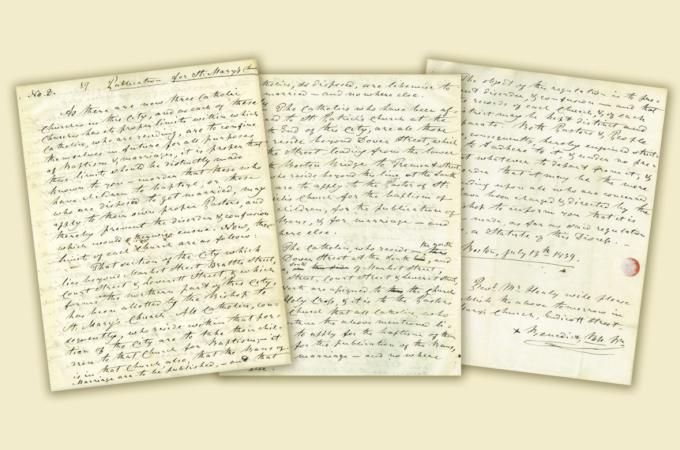The first new parishes for the city of Boston
On July 13, 1839, Bishop Benedict Fenwick of Boston issued a circular letter for publication, notifying the city's Catholics that three parishes now existed within the city limits. He requested that they "confine themselves in the future" to their respective parishes "for all purposes of baptisms and marriages," which would "prevent the disorder and confusion which would otherwise ensue."
He continues to specify the boundaries for each parish, starting with St. Mary in Boston's North End neighborhood, which would serve those residing in the northern part of the city "beyond Market Street, Brattle Street, Court Street, and Leverett Street."
The second parish was St. Patrick's in the South End, which would serve "those who reside beyond (south of) Dover Street, which is the street leading from the lower South Boston Bridge to Tremont Street." The parish still exists today, but in 1874 was relocated to Roxbury, where it occupied a more central location in relation to its parishioners.
The final parish he names was the first established in Boston, that of the Cathedral of the Holy Cross on Franklin Street, which would serve those residing between the two aforementioned parishes -- north of Dover Street and south of the St. Mary's parish line.
In early Catholicism, the main unit of organization was the diocese, and priests would be sent by a bishop to rural areas then return for a new assignment. By the fifth century there are signs that priests started to be given long-term or permanent assignments in those areas, which began to be defined by geographical boundaries. The parish system was not formalized, however, until the Council of Trent (1545 to 1563), which also clarified the roles of bishops and priests within this system.
As Bishop Fenwick states, there are several practical purposes for this system of organization. Couples were urged to marry in their parish as banns would be announced only in that parish. He also clarifies that sacramental records were to be maintained separately, by parish, as they still are today; this would include any missions or chapels that fell within the parish boundary.
He insists that both pastors and people are to strictly adhere to this as it is a statute of the Diocese of Boston. A note at the end asks that Father Michael Healy, pastor of St. Mary, please publish this notice at the parish church on the following day.
In a historical context, the letter from Bishop Fenwick illustrates the slow growth of the early Catholic community. When the Diocese of Boston was established in 1808, the city was served by one parish, the Cathedral of the Holy Cross, the first Catholic Church in New England completed five years previously. When this letter was written just over 30 years later, the number had only increased to three within the city limits.
Contributing factors were the small numbers of Catholics, which in one sense made it unnecessary for additional parishes, but also meant few families to fund the construction of new parish churches. This would change in the coming decades due to the arrival of Irish Catholics, and by the time another 30 years had passed there would be nearly 20 parishes in the city. There was also a constant shortage of priests, and since many were needed to travel between missions throughout New England, it would be a poor use of resources to have too many assigned to one specific parish. In fact, while our collaborative system may seem like a new idea, as the number of new parishes grew faster than the clergy it was not uncommon for a pastor to serve more than one parish during the 19th century.
- Thomas Lester is the archivist of the Archdiocese of Boston.



















